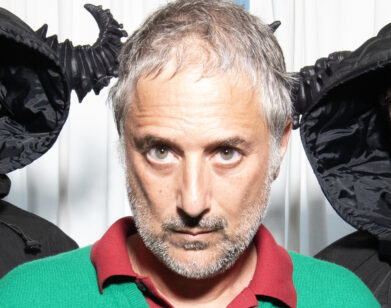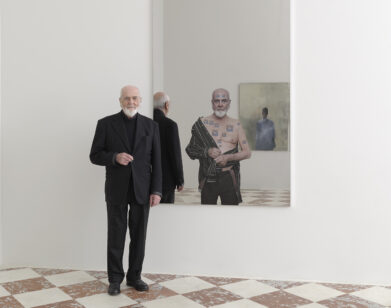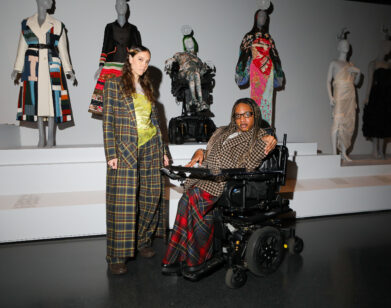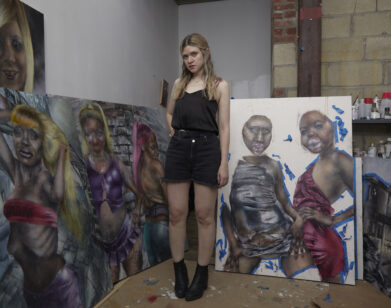Harmony Korine Plays Dracula
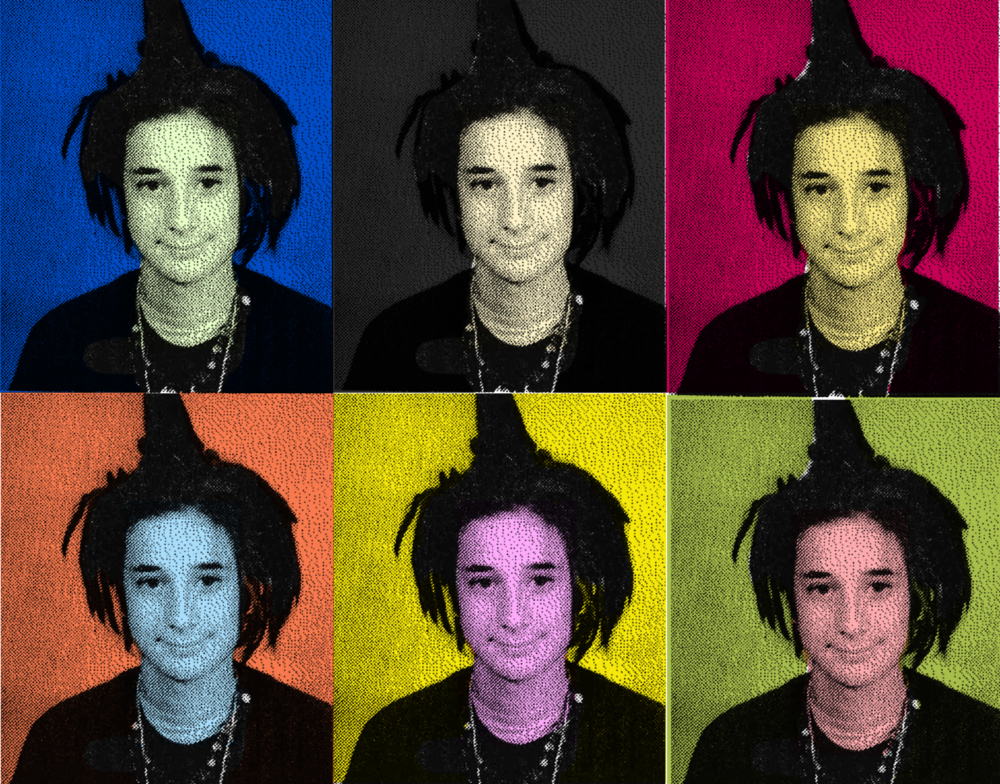
On the surface, Harmony Korine may not seem like a dark dude. The director, writer, and artist has been photographed with a pink flamingo, dressed Matthew McConaughey in a marabou feather robe in his latest film The Beach Bum, and was spotted at film festivals wearing a sailor’s cap. (For the record, Korine does have a sailboat, where he plays poker on an iPad while drinking Mountain Dew).
But those familiar with his work know that Korine has a deep-seated dark side. He did, after all, write the script for Kids, the controversial 1995 film that follows a teenage boy who sleeps with as many virgins as possible without telling them he has HIV. He then went on to direct Gummo in 1997, about a bunch of stoner boys in rural Ohio, and Spring Breakers, in 2012, a romp that follows college kids on a booze bender in Florida.
At age 46, with salt and pepper hair peeking behind his sailor hat, Korine has chilled out a bit, spending most of his time making stoner art—trippy Op Art paintings in oil that’s easy to get lost in. And yet, his dark streak hasn’t quit. “Birth Machine Baby: H. R. Giger and Mark Prent,” the first ever exhibition curated by Korine, is a collection by two artists whose work most consider nightmarish, if not downright creepy. At the opening Tuesday night at Gagosian gallery on 75th and Park Avenue, an uptown lady walking her dachshunds stopped, peered in the window, and said “Umm, okay,” before skittering off. Inside the gallery, a torso of a decapitated man screaming as he’s being eaten alive by sea creatures (by Prent) sat alongside a series of infants holding machine guns, ready to battle the world’s overpopulation (a series by Giger, the artist well-known for creating the aesthetic behind the Alien film franchise). But creepy? Korine doesn’t see it that way. To him, each artwork represents a different film, or character from a film, that hasn’t been made yet. We spoke to the cult filmmaker about curating the way Dracula would, Satanism, and the dark powers of Taco Bell.
———
NADJA SAYEJ: Hi Harmony! You’ve actually written for Interview before, right?
HARMONY KORINE: Yeah! I’ve done some stuff—I’ve interviewed Paul McCarthy and William Eggleston.
SAYEJ: So now you’ve curated a show of H.R. Giger’s work. What a polarizing figure. Did you come up with this idea, or were you asked to do it?
KORINE: Larry Gagosian asked me if I wanted to curate the space at 75th and Park Ave. I had this idea of putting HR Giger and Mark Prent together, not showing paintings but all sculptures and installations.
SAYEJ: What got you into such creepy shit?
KORINE: I always loved Giger’s work as a high school kid. The work was so ubiquitous, and you saw it everywhere in posters and in books. They both inhabit this grey area in the art world.
SAYEJ: What did you love about Giger’s work growing up?
KORINE: Its interesting because growing up, Dungeons & Dragons, heavy metal music, metal iconography and stoner art was such a thing in high school. Giger was kind of like the patron saint of that sci-fi fantasy world. I like how it was co-opted by that, and that people in the art world didn’t take it seriously or even acknowledge it.
SAYEJ: Really?
KORINE: When I saw some of Giger’s artwork in person, the artistry and detail was amazing. I liked how it had been co-opted by, this, I don’t know what you want to call it, but this… culturally populist adolescent male fantasy world. When you see it in person, you see it’s serious. When I saw his art, I fell in love with it again.
SAYEJ: Where did you first see Giger’s artwork?
KORINE: I saw it in Europe, then I saw a few models he used for Alien at a space in Milan.
SAYEJ: I saw his furniture at the Nordic Biennial, and it was so creepy. The Queen of Norway came, and she was disgusted.
KORINE: Yeah, I love that! [Laughs]. The furniture is really great; the chairs and the tables with the Alien spine?
SAYEJ: And the skulls?
KORINE: And the skulls, it’s amazing! That’s what I’m saying—it blurs the lines between design, furniture and movies. If you think about movies and how Alien influenced how people envisioned fantasy and horror … that type of iconography, that sci-fi vernacular really made an impression on pop culture. I feel like the influence is vast, you know?
In some ways, Giger is one of the most important artists of this century. If you think of it in terms of influence and where you see it, how it has been adapted, it’s really big. A lot of his work is off-putting, startling, and confrontational. But at the same time, it’s very beautiful and there’s an elegance to it. It feels like there’s no sense of time. It could have been made in the future. There’s a nod to the past and the future. It kind of exists in its own realm. They’re self-contained. Giger creates a whole kind of inner logic, an inner world, an inner conflict. And it comes from somewhere beyond outside influences. It’s more to do with an internal id of horror and beauty.
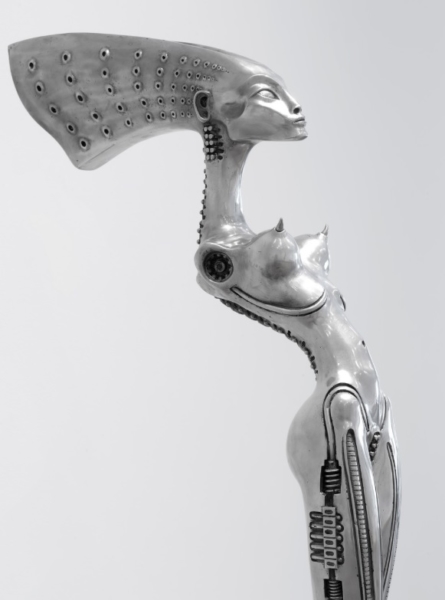
H.R. Giger, “Nubian Queen (Carmen)”, 2002. © H.R. Giger Museum, Gruyères, Switzerland. Photo: Rob McKeever.
SAYEJ: Did you know that HR Giger was a Satanist?
KORINE: A Satanist?
SAYEJ: Yeah.
KORINE: I didn’t know that. I didn’t even know that’s a real thing?
SAYEJ: He’s on the official Church of Satan website as an occult artist, which I find strange.
KORINE: I would wonder if that’s true.
SAYEJ: I remember reading about Giger’s studio windows being boarded up with black sheets, but maybe it was all a part of the theatrics.
KORINE: It’s interesting. It is dark, but it’s also is a celebration of figures and of possibilities, alternate universes. It is dark because that’s part of the world. But there’s also something transcendent about it. It’s not just horror or fantasy, it has its own world. Giger and Mark Prent are both post-irony. It doesn’t really deal with any type of irony. It feels much more… like dreams, you know? Dreams and ideology. Fantasy. What the world can be. It’s not cloaked in irony, which feels right for this time.
SAYEJ: Why do you say that?
KORINE: I don’t know, I think it’s just nice to see things and interpret them in a specific way, in a coded vernacular. It doesn’t feel like the work is a joke or a riddle. When you see the work in person, you really see how beautiful they are. They’re so well made.
SAYEJ: It’s so interesting coming from you because, especially with your last film The Beach Bum, which had a positive feel-good tone to it, I see you in this curator role, and you’re kind of like Dracula.
KORINE: [Laughs]. Really? Dracula?
SAYEJ: In your curator role, you become Dracula. Both of those artists are quite dark. I’m curious what you’re trying to get to with both of them?
KORINE: I don’t know! Maybe it’s shocking, but it feels fun to me. Each artwork is almost its own movie, its own narrative. You can almost step into it. I guess coming from the film world, I never saw it as super dark or horror. It could be shocking, though. But that’s exciting.
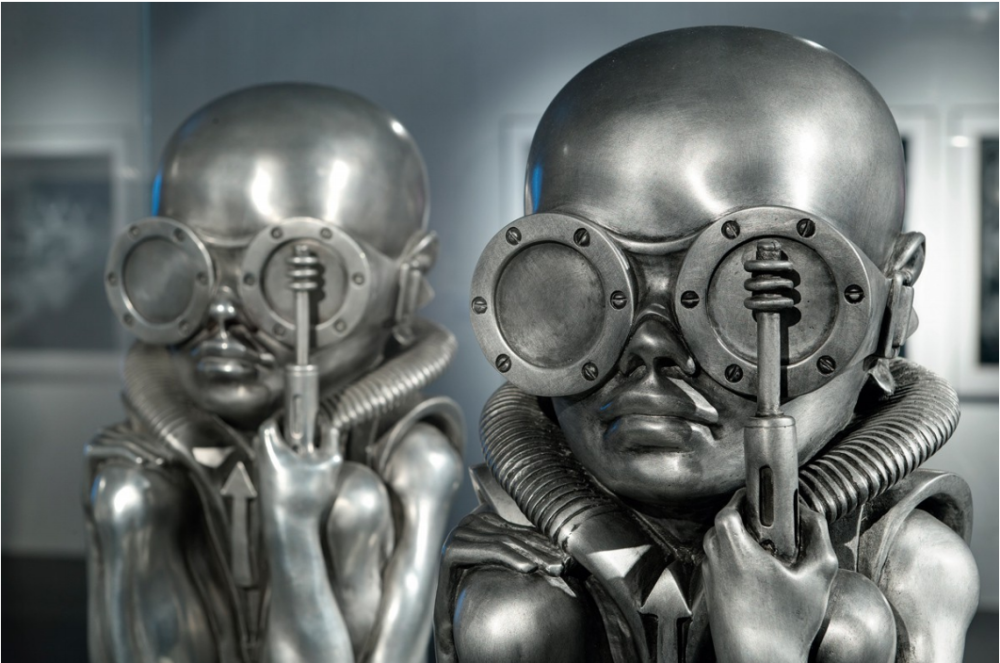
H. R. Giger, Birth Machine Baby, 1998. © H. R. Giger Museum, Gruyères, Switzerland. Photo: Matthias Belz.
SAYEJ: Do you remember how you found out about Mark Prent’s artwork? He’s an obscure artist. Not a lot of people know who he is.
KORINE: We used to talk about him with friends and animators and stuff. I have some artist friends who really admire him. He’s a cult figure, someone who should be more known than he is.
SAYEJ: He’s done some wacky stuff—a tarantula on a baby’s head, a man with no arms screaming, covered in coral and fungi.
KORINE: Yeah, and he’s screaming. I love that piece. He has a tribal tattoo and fish scales. It’s a great character out of a movie that was never made.
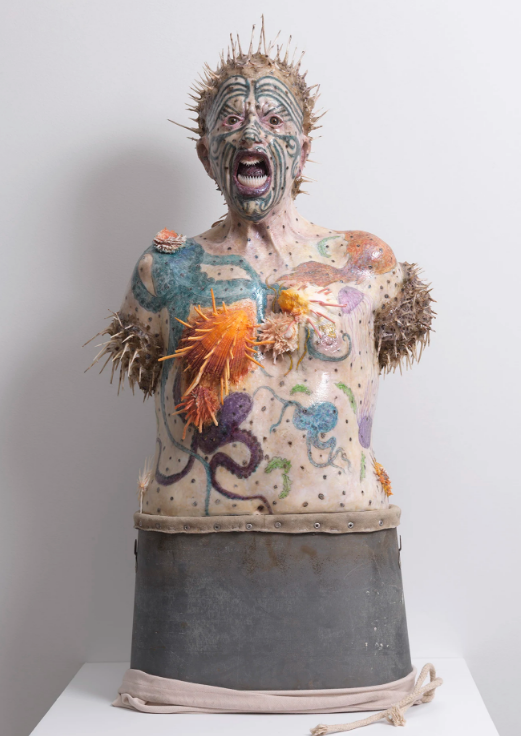
Mark Prent, Icthymorph Redux, 2017. © Mark Prent. Photo: Rob McKeever. Courtesy Gagosian.
SAYEJ: Maybe that’s your style.
KORINE: It’s about the time we live in and what I felt like would be nice to see, what would be exciting. And what I didn’t want to see. I felt like it’s great to introduce to people who have never seen it. Kids would like it. The youth would be into it.
SAYEJ: What was the hardest part of playing curator, Dracula?
KORINE: Putting it all together. I don’t really curate shows, it’s not really my thing. It was a lot of fun. It encompasses a lot of things: fine art, movies, acrobatics, illustration, horror, fantasy, love. It’s a swirl. There’s a visceral component experiencing it in real life. I encourage people to see it up close.
SAYEJ: Are you spending most of your time painting these days?
KORINE: I try to just do my thing. I make movies, make art, write things, entertain myself.
SAYEJ: Are you going to Miami for the art fairs, or are you over it?
KORINE: I’m going to do something this year. Usually I skip it, but I live there, so I have something special coming up this year. I’m not finished, but it’s a video projection and eight large photos. I use a different kind of technology that has an oddball component. So, you can feel like you can walk into it.
SAYEJ: Are there going to be tacos? I know you love Taco Bell.
KORINE: Always! I’m going to get them to cater it. I love Taco Bell’s Crunchwrap Supreme.
SAYEJ: That’s what I’m talking about!
KORINE: I loooooooove the Crunchwrap Supreme. I eat, like, five to six of them a day.
SAYEJ: How? That’s not healthy!
KORINE: Sorry! Not a day, a week… I spread it out.


